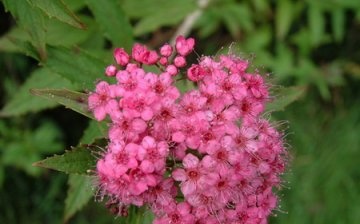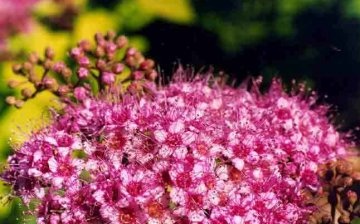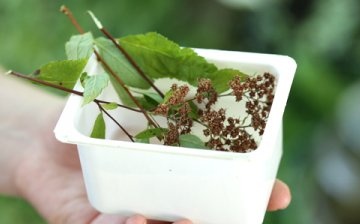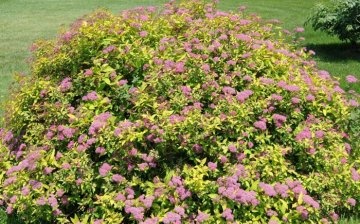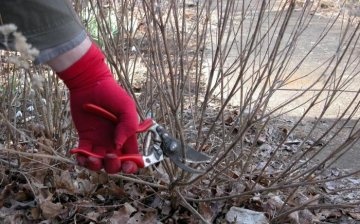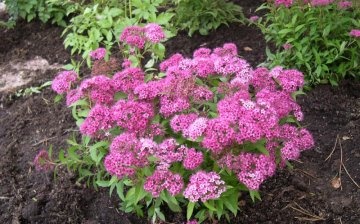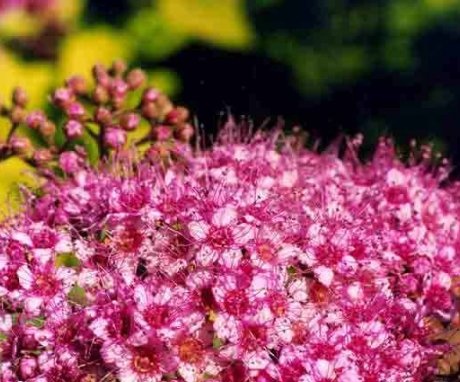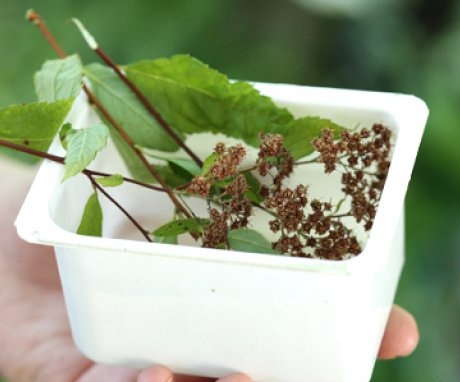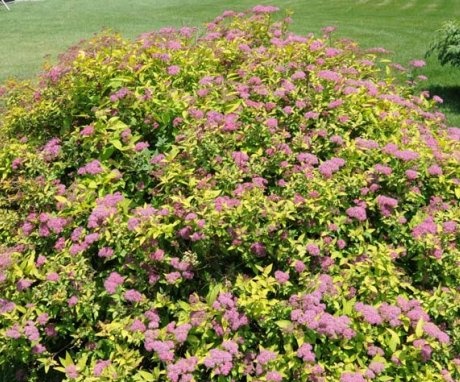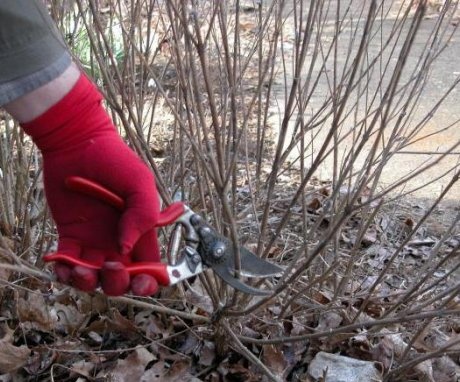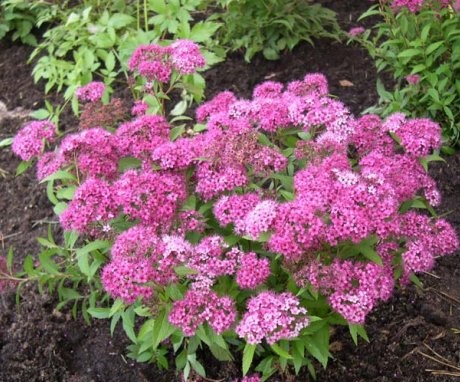Spirea Bumalda - an exquisite ornamental shrub for your garden
Particularly popular view spireas, since the end of the 19th century, is a cross between Japanese spirea and white-flowered spirea - Bumald. It is decorative, undemanding in care, it can grow in any climate, therefore it is an ideal option for decorating a garden.
Content:
- Popular varieties of spirea Bumald, their description
- Shrub propagation and its use in landscape design
- Growing conditions for spirea Bumald: soil, temperature, lighting
- Shrub care: watering, feeding, pruning, preparing for winter
- Spirea pests, effective measures to combat them
Popular varieties of spirea Bumald, their description
This hybrid of spirea found its fan for a long time, because the appearance of the bush allows it to become an adornment of any site. No more than a meter tall, bushes with a lush and dense crown similar to a ball bloom all summer, delighting with bright inflorescences from pale pink to dark red. Breeders have bred a lot of different varieties of this ornamental plant:
- Krisla has unusual leaves, slightly twisted and cut along the edges, with a dark green color, and when they bloom, they acquire a burgundy tone. The scutellum inflorescences of the plant are dark purple in color.
- For the variety Gold Flame a change in the color of the leaves depending on the season is characteristic: in the spring - pink with an orange tint, in the summer they turn yellow, and in the fall they turn dark orange. And in the multi-colored foliage, bright pink corymbose inflorescences can be seen.
- The shrub with narrow leaves Anthony Vaterer has bright red flowers, so it looks very good in plantings with white hydrangea.
- The leaves of the Darts Red spirea are also beautiful, from pinkish in spring to red in autumn, and in summer they remain dark green. And the splendor of the crown of a shrub about a meter in diameter with crimson flowers pleases the eye during the whole warm period.
- The Atrosea variety belongs to tall shrubs, up to one and a half meters, everything is bright in it: reddish leaves and dark pink inflorescences more than ten centimeters in diameter.
- Elegance has a wider crown and large inflorescences of a white-pink hue. Planting spireas from afar seem like white-pink clouds floating in the garden.
The variety of varieties of spirea Bumald makes it possible to make the garden a blooming paradise on earth.
Shrub propagation and its use in landscape design
Like all types of spirea, Bumald reproduces in different ways:
- Hybrid varieties are better seeds do not propagate, because the seedlings will lose their distinctive species characteristics. But if you still want to see what comes out of the seeds, then you can sow them in boxes in March. As soon as the first sprouts appear after 3 months, they dive to the garden. Pinching the end of the main root is imperative - this will help develop a more powerful root system... Spiraea sprays grown from seeds will begin to bloom only no earlier than three years from the day of planting.
- To preserve varietal characteristics, the shrub is propagated more often. cuttings... Prepare material for propagation from shoots that have a semi-lignified trunk. Pruning branches are produced both from the top and from the middle of the bush about 10 centimeters long. Having planted the cuttings in the middle of summer in the ground and regularly moisturizing them, in the fall they already get sprouts with roots. By processing cuttings with phytons before planting, you can get a quick one hundred percent rooting.
- One of the most reliable methods is the propagation of spirea by layering. In the spring, the lateral branches of the shrub are bent down, sprinkled with earth, for the reliability of pinning with wire or tied to pegs in an upright position. Correctly caring for the layers, they get independent plants by autumn or next year. The first inflorescences on young bushes must be removed so that the plants develop faster.
It should be noted that the most preferred way of reproduction of spirea is grafting, so with others, a large percentage of splitting of signs is obtained, that is, when grown, individuals with white flowers will appear.
The varietal variety of Bumald's spirea helps to use it in different design solutions.
Low curvaceous forms look great in rockeries. The combination of leaves and flowers of different colors make the garden bright and unforgettable. On green lawns lawn flowering plantings of spirea are eye-catching. Some use the bush for hedges, in mixborders. Especially Boomalda is preferred for tamping ankle bushes such as lilac... Spireas are good in the neighborhood with other flowering shrubs - just show your imagination. And with conifers nearby, the ornamental plant opens up in all its glory.
Creating different forms of the crown of the spirea with a haircut is ideal for her, as she tolerates it well. And pruning faded shoots contributes to the rejuvenation of the shrub and active flowering in the future. Spirea Bumald is an ornamental plant, loved by designers and gardeners for its democratic attitude towards neighbors in planting and unpretentiousness.
Growing conditions for spirea Bumald: soil, temperature, lighting
Despite the fact that spirea belongs to unpretentious plants, it still has priorities in choosing a place for growth and soil selection. Ornamental shrubs of this species love light or partial shade, so open sunny meadows are chosen for them. The soil is selected for planting the usual sod with the addition of peat and sand.
The richer the soil on which Bumald's spirea grows, the more magnificent its spherical crown.
It is better to plant the bushes in the winter in the first autumn month, choosing a cloudy day. If the groundwater is close at the landing site, then a drainage layer ten centimeters thick is poured onto the bottom of the landing pit, which is ordinary rubble or broken brick with sand. In the depth of the hole for the spirea, they reach half a meter with the condition that the root collar is at the level of the soil or slightly higher by 1-2 centimeters.
When planting spireas in groups, they maintain a distance between the bushes from half a meter to a meter. Spirea Bumald grows in all climatic zones, without going far to the north. And the shrub will begin to bloom depending on the beginning of the warm period and its duration.
Shrub care: watering, feeding, pruning, preparing for winter
The external attractiveness of the spirea does not mean at all that it is capricious. No, the plant thrives under normal conditions. The soil should be constantly moist, but without stagnant water, because of this, decorative plantings are watered moderately. Only in dry summers or after trimming twice a month, a bucket of water is poured under each bush.
Spirea feeding:
- Spirea is fed three times per season mineral fertilizers in complex.
- After spring pruning, it is imperative that a fertilizing prepared from a bucket of slurry mixed in five buckets of water, with the addition of a spoon of superphosphate, is added under each bush.
Several times per season it is necessary to loosen the plantings of an ornamental plant. Mulching also will not hurt and will minimize the care of the bushes. From materials for mulch, peat, sawdust, as well as layers of green moss are suitable. They will protect the soil from drying out and compaction during the rainy season, and the weeds will not be able to break through the mulch.
One of the most important rules in caring for a spirea is pruning the bushes:
- Prune branches to buds that are well developed. The removal of small shoots must be carried out completely. There is no need to fear that this procedure will damage the bush, on the contrary, it will make its crown more lush and powerful.
- Autumn after graduation flowering for five-year-old bushes, the apical part is cut off at least 30 centimeters from the ground.
- Bushes over 6 years old can be trimmed to a stump after they have faded. Old shoots, if not removed, will dry out and fall to the ground, and the shape of the shrub will deteriorate.
Spirea is referred to as winter-hardy plants, but it is necessary to prepare it for the cold weather, especially young growth. To do this, the bushes are covered with foliage or spruce branches, pine trees. Also, during the winter, it is necessary to cover the plantings with snow. To fully guarantee that frosts will not damage the bushes, they can be bent to the ground, pinned with wire, and covered with peat or dry foliage.
Observe the basic rules for caring for ornamental shrubs - enjoy its flowering all summer and extend the life of the plant to the optimal period of 30 years.
Spirea pests, effective measures to combat them
To protect the spirea from pests, it is necessary to follow all the measures of agricultural technology and care for it. Although it is resistant to pests, some of it still occurs:
- Loves sweet shoots of ornamental shrubs aphid... You have to fight with it throughout the entire period. flowering spireas. On one leaf of the plant, sometimes up to 30 copies of the pest can be found. One hundred percent success in the fight against aphids is distinguished by the drug pyrimor in combination with bitoxibacillin. The granular agent is introduced into the ground at the beginning of the growing season of the plant in early April. Will also help spraying plantings infected with aphids with a solution of laundry soap or onions.
- Spirea leaves can be damaged by the rosacea, which appears at the end of May, when night frosts recede and the air warms up to 15 degrees Celsius. With harmful caterpillars, destroying plant leaves, fight in the same way as with aphids.
- At the end of the first summer month, a rosaceous miner may appear at the top of the leaves, which after a while goes into the soil to harm the plant for the next year. It is possible to deal with them manually: simply collect the pests together with damaged leaves and destroy them. The second method includes spraying spirea bushes with insecticidal preparations such as Actellik.
- Serious pests of Bumald's spirea include the spider mite, the females of which spend the winter under fallen leaves, and then in the spring move to the underside of the leaves, entangling them with cobwebs and laying eggs. A mite can give up to 10 generations per season. Affected leaves are recognized by whitish spots, while the plant looks sick and slowly withers away. The tick becomes especially active in dry summer. The fight against this pest is carried out with the help of phosphamides, karbofos by spraying... But the most effective drug is Acrex. They can be processed at the beginning of the reproduction of ticks, when there are no more than 5 individuals on a leaf.
Beautiful shrubs with bright flowers of all shades of red and unusual color leaves, attracting with their aroma and belonging to the Rosaceae family - this is about Bumald's spirea.Every gardener needs to have these plants in the garden, because they are not only extremely decorative, but also unpretentious, they can grow in any, not too swampy and shaded places.
To create an atmosphere of sophistication and chic in the garden, this is an indispensable plant.
Here, in the article, you can get information about the reproduction, cultivation and care of summer-flowering shrubs of Boomald's spirea. The question of plant pests, how to effectively deal with them is also highlighted.
More information can be found in the video:



